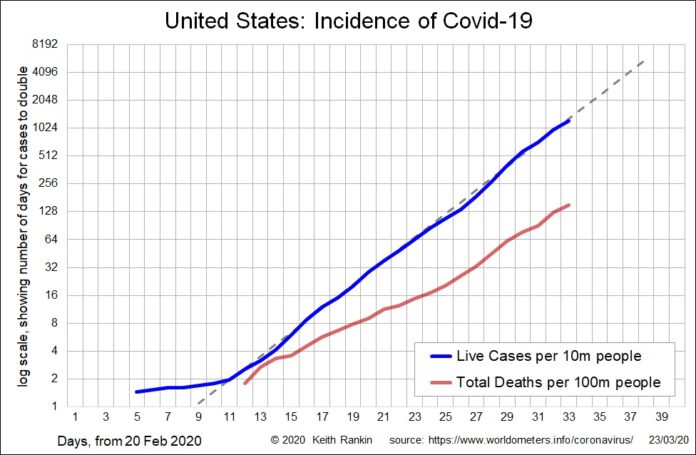Analysis by Keith Rankin


The USA has been on a consisted exponential growth path since day 11 (March 1). Italian Covid‑19 incidence levels – currently just over 8,000 known cases per 10 million people on 23 March – will be reached in the United States by day 39 (Sunday, March 29) if there is no decline from this path. Further death rates in the USA are likely to accelerate; there is no obvious reason why deaths as a percentage of known cases should be substantially less in the United States than in Italy.
The United Kingdom chart is on an identical grid to the USA chart. While the growth rate of known cases is on a slower exponential growth path (and projects to reach present Italian levels a day later than USA), the UK death rate is on a faster growth path. The most likely explanation here is that the UK case data has becoming increasingly divorced from the actual incidence of Covid‑19 in United Kingdom. While the UK undercount may be less than Italy’s, it is very much the death tally that has now become the key indicator in the UK (as it has in Italy and Spain). Covid‑19 deaths per 100 million people have reached 500 in the United Kingdom, but 150 in the United States.
These charts convey a more pessimistic message than others I have created. Earlier charts emphasised the slowing of Covid‑19 growth in Asia, and hinted of slowing growth in Italy.
One further matter to note is that the rate of spread of Covid‑19 is probably not greater in colder places, as first seemed to be the case. (The rate of spread in Australia seems to be similar to that in Canada.) I now suspect that Scandinavia got the virus early – and rapidly – because Scandinavians (like New Zealanders) travel a lot. But, with comparatively few direct flights from China to Scandinavia, there was likely less vigilance with respect to locals returning from Covid‑19 hotspots in Asia in January. (Also, early Norwegian cases were linked to aurora tourism, via cruise ships.) The ‘good news’ from this realisation is that the crisis in New Zealand should not worsen in May or June, as winter takes hold. The ‘bad news’ is that warm climates may not check the spread of the virus in the likes of India, Indonesia and Brazil.








